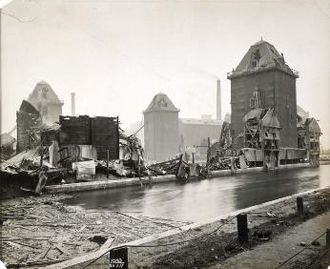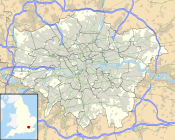Silvertown explosion facts for kids

The Millennium Mills following the explosion
|
|
| Date | 19 January 1917 |
|---|---|
| Time | 18:52 UTC |
| Location | Silvertown, London |
| Deaths | 73 |
| Non-fatal injuries | More than 400 |
The Silvertown explosion was a huge blast that happened in Silvertown, London, on Friday, January 19, 1917, at 6:52 PM. It occurred at a factory that was making explosives for Britain during World War I.
About 50 long tons (a very large amount!) of trinitrotoluene (TNT) exploded. This terrible event killed 73 people and injured over 400 more. It also caused a lot of damage to the area around the factory. While this was a major explosion, it wasn't the only one during the war. Other similar factory explosions happened in places like Faversham and Chilwell, also causing many deaths.
How the Factory Worked
The factory was built in 1893 by a company called Brunner Mond. It was located near the River Thames in Silvertown. Originally, it made things like soda crystals.
Before World War I, part of the factory was not being used. When the war started, Britain needed more explosives. So, the government decided to use this empty part of the factory to purify TNT. Purifying TNT was actually more dangerous than making it from scratch.
Even though the factory was in a very busy area with lots of people living nearby, TNT production started in September 1915. The method used was known to be very risky. The factory purified about 9 long tons of TNT every day until the explosion destroyed it.
Another TNT factory was built in 1916 in a less populated area called Gadbrook. This new factory had better safety rules and made even more TNT than the Silvertown factory.
The Big Explosion
On January 19, 1917, a fire started in a room where TNT was melted. People were trying to put out the fire when, at 6:52 PM, about 50 long tons of TNT suddenly blew up.
The TNT factory was completely destroyed right away. Many buildings nearby, including the local fire station, were also ruined. A lot of the TNT was in train cars, waiting to be moved.
Pieces of the factory flew for miles, and hot rubble started new fires. A large gas tank on Greenwich Peninsula was damaged, creating a huge fireball from 200,000 cubic meters of gas. Nearby warehouses, covering a large area, also lost goods worth thousands of pounds. Even the local church, St Barnabas', was badly damaged.
In total, 73 people died, and over 400 were hurt. About 70,000 homes were damaged, and 900 homes close to the factory were completely destroyed. The cost of the damage was huge, estimated to be millions of pounds.
The number of deaths was lower than it could have been because of the time of day. Most factory workers had already left, and it was too early for many people to be in the upper floors of houses, which were hit hardest by flying debris. However, several firefighters and volunteers who were fighting the earlier fire were killed or badly injured.
The explosion was so powerful that it broke windows in the Savoy Hotel, which was miles away. People could see the fires from places like Maidstone and Guildford. The sound of the blast was heard up to 100 miles away, even in places like Sandringham in Norfolk. The sound traveled far, but not everyone heard it because of how sound waves move through the air.
The Explosion in Stories
The Silvertown Explosion has appeared in several stories and books:
- In the TV show Upstairs, Downstairs, a character named Ruby Finch works at the factory. The explosion is heard and felt at her old employer's house, and Ruby returns in shock, covered in yellow dust.
- The comic strip Charley's War shows the hero, Charley Bourne, returning home to Silvertown after being injured in the war. He sees the aftermath of the explosion. Later stories in the comic also talk about fears of another disaster.
- In the Charlie Higson Young Bond novel Double or Die, the factory's original company, Brunner Mond, is part of a clue, and the explosion is mentioned.
- The book A Study in Murder by Robert Ryan also mentions the explosion, showing how it broke windows in a hotel far away.
See also
- List of the largest artificial non-nuclear explosions


